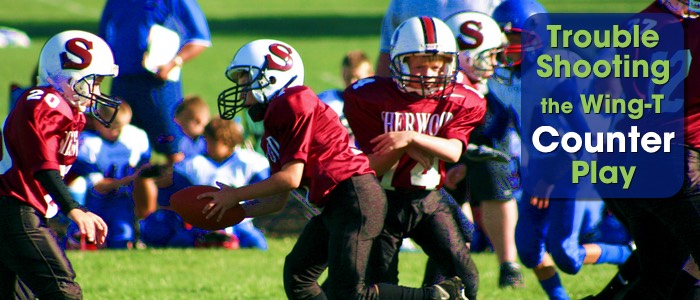Troubleshooting the Wing-T Counter Play

Last week I covered troubleshooting the Belly Series Down play so I figured it would be good to take some time to cover the key next play in the Belly series which is the Counter play. I’m not sure if this counter play is mainly an Oregon creation or if there’s some lineage I haven’t discovered yet. The Tubby Raymond The Delaware Wing-T book does not have this play, though the 932 Counter XX has similar blocking.
The Counter is a staple in our offense. One thing we like to say is “gash on with the downplay, score the touchdown with the counter play”. The play is not difficult to run, though it takes some time to perfect as it is slower to develop and footwork and precision will be key. Let’s start by reviewing assignments for this play.

The play-side rules (tackle, guard, and center) are simple: they will down block in (in this case, to the right as the play is going left). The back-side guard will pull flat and kick out first man he sees outside the tackle. The back-side tackle must reach to play-side and help the center protect the back-side A and B gap. We pull the TE and have him lead through the hole.
The QB will use similar footwork as he would on the Down play, and you can either ride a belly fake for one step or just use a proximity fake. The ball carrier will usually open step for a delay, then follow the TE through the hole, taking an inside handoff from the QB. We prefer inside handoff as it hides the play a bit more.

When you run this play well, the running back will make a sharp cut upfield inside the kickout block, usually just over the center (A or B gap). The video above (full video link) is well run Counter play. Good shoulder position by the kickout (right kickout == right shoulder), and the TE did his job to screen the outside linebacker just long enough for the running back to get through. I think the FB made an OK fake, and in this example you’ll see there was just a proximity fake by the QB.
Let’s cover some of the key problems that you might have installing this play:
- Play-side tackle must obey his down block rule, which is to leave the defender alone if he is heads up or outside shade.
In this video you’ll see the left tackle make a decent effort, but I think he made two mistakes. First, I can tell by his first step (he made a left reach) that his technique was off and that he should have left the defender (#66) alone. Second, he then allowed the defender to get inside leverage and penetrate the gap. I would much rather see this defender by the man we kick out. An aggressive defender like this will usually over-penetrate and make an easy target for the pulling guard.
This underscores the importance of teaching proper footwork, especially that first step. If the tackle stepped down to the right, his path would have taken him away from this defender and he would have instead helped pick up the blitzing LB.
- The pulling guard must use proper kickout technique, which will be a same-shoulder block. We tell the pulling linemen to “put your head in the hole” as a reminder.
In this video you’ll see the left guard (#32) do a nice job of pulling but then taking too wide of a path to the kickout defender, allowing him to take an inside path and make the tackle.
The cross-block and down block drills I’ve covered previously should help with this, but you should also work with your guards on the pull / kick-out technique directly. I also teach the guards to get some depth after crossing the center to get a better angle for the kickout.
- The TE has to be committed to finding a defender.
A few things went wrong in the video above. Once again we see poor technique from the left tackle as he effectively reach blocked the defensive end. Still, at least he was able to control him and turn him back to the middle! The pulling guard probably did as well as he could as the defender over-penetrated and took himself out of the play. The TE (#57) though managed to run past two defenders before finding someone to block. Additionally, the left guard (#32) did a nice job getting to the second level, but poor head and shoulder technique allowed the LB to scrape to play side and spill the play.
Technique-wise, I think the TE needs to stay lower (he’s a tall kid, so this was difficult) and be in a better break-down position. It is hard to balance the need to be quick and get to the hole to lead block while not running past defenders. This is one reason I love having tight ends and guards who are also linebackers.